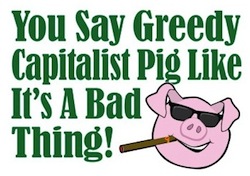You might think that capital gains tax (CGT) will never apply to you. And if all your investments are in ISAs, SIPPs, or your own home, then you could well be right.
But let’s say for whatever reason you’re forced to realise a capital gain (or more likely gains, plural) big enough to take you over your CGT allowance for the year.
One simple emergency response is to consider offsetting your capital gains with capital losses where possible, to reduce the tax you’ll pay – even if it means selling shares or other assets that you had planned to keep for the long-term.
This ‘crystalising’ of losses is a very straightforward way to reduce your CGT liability, yet it’s often forgotten or misunderstood.
The key is you’re charged CGT on your total taxable gain for the year, which is:
The total gains on your profitable taxable investments
minus applicable losses on investments that lost money
minus any reliefs
minus your annual capital gains allowance
= Your total taxable gain
In other words, if as well as the gain (profit) you’ve made, you’re also showing losses on other taxable investments – such as shareholdings that have fallen in value – then by selling them too and offsetting those losses against your gain, you can reduce and maybe even eliminate your CGT bill.
Losses in ISAs and SIPPs don’t count: Remember, you can only offset gains using losses on taxable assets. (See my article on capital gains tax for an explanation of what counts as a ‘taxable asset’). RBS shares held in your online dealing account that are down 50% since you bought them can be set against gains if you sell them. RBS shares held inside your ISA cannot (just as they would not be liable for CGT if they rose).
At the risk of belaboring the point, the crucial thing is you must realise/crystalise your losses to use them.
It’s no good – for tax purposes – having a portfolio of clunkers sitting in the red in your dealing account that you’re waiting to come good again. Those losses don’t count until sold.
You have to dump the devalued shareholdings, take the loss on the chin (keeping a record for the taxman) and then tot up all the losses and subtract them from your gains to calculate your (now lowered) total capital gain for the year.
This isn’t rocket science, but I’ve seen people say it’s not worth it, or not understand how it works, or not think to do it – all mistakes, in my view.
If you’re going to pay a taxable gain and have potential losses to hand, then realising and offsetting those losses against that gain is free money.
Note: If you make an overall loss in a tax year, after subtracting losses from gains, then you should inform HMRC when you submit your tax return, so you can carry this loss forward to reduce gains in future years. Losses can be a valuable asset, but only if you tell HMRC!
Worked example of offsetting losses against capital gains
Here’s a made-up example to illustrate how it works.
Imagine you bought shares in Monevator PLC in 2015 for £10,000. You bought them outside of an ISA.
In 2016, a bidding war between Richard Branson and Warren Buffett breaks out for control of Monevator, and your shareholding rises tenfold to £100,000.
Having no faith in the goons running this website, you decide to sell up, take the money, and run.
Your investment has grown to £100,000, so to work out the gain you subtract the £10,000 you initially paid to buy the shares.
The gain is therefore £90,000.
Subtracting your annual CGT allowance from that gain (and assuming you’ve not realised any other gains in the tax year) means you’ve made a taxable gain of:
£90,000 minus £11,100 = £78,900
A hefty tax bill will clearly be due on that £78,900. If it were all charged at the higher CGT rate on shares of 20%, then you’d pay £15,780 in tax.
But wait!
While sitting in a pool of your tears as you lament the demise of your favourite investing blog AND your imminent tax bill, you remember some shares in other companies that you continue to hold that didn’t do so well.
In fact, your dealing account shows you’re currently down £20,000 on your investment in Sky, and you’re also £35,000 underwater on the Daily Mail and General Trust.
You had planned to hold on for a recovery in their prices. But given the imminent tax bill, these shareholdings are probably worth more to you dead than alive.
If you’re paying the higher-rate 20% of CGT, then realising these losses and offsetting them against your CGT gain will ‘earn’ you £200 for every £1,000 of loss.
Note that nobody is suggesting that you make a loss just to reduce your tax bill (well, some US Republican diehards might, but I’m not).
In this example you’ve already made the unprofitable investments. The damage is there already in the losses on your shareholdings. By selling up and offsetting those losses against your taxable gain, you’re reducing the impact on your total wealth.
What’s more, you can reinvest the money you raised from selling your losers, too.
This means there’s a potential double-whammy at work of using the losses to offset your gain, and then seeing your reinvested money rise in value in the future.
Beware the 30-day rule! Note that you can’t repurchase the same company’s shares within 30 days of you selling them and recognising the loss, according to HMRC’s bed and breakfasting rules. If you do repurchase the same assets within 30 days, the loss does not count as crystalised and so cannot be set against your gains.
The 30-day rule means you’d have to wait a month to repurchase exactly the same shares or fund that you sold for a loss to offset that loss against gains. Not likely to be a disaster, but there’s a danger that the market could move against you.
On the other hand the shares or fund might get even cheaper! A month is a pretty short and random time in the markets.
However there’s also nothing to stop you investing the money raised in another share or fund you fancy – perhaps a share from the same sector or even a close competitor – or putting it into a similar but different ETF or fund.
Many active investing Monevator readers will have plenty of ideas for where they’d like to deploy new money, so this influx of cash could be a silver lining to realising losses. Cutting losers and running winners can be a good discipline when active investing, depending on your strategy.
Remember your overall asset allocation though. If you’re a passive investor in broad asset classes, you should ideally be selling winners and adding to losers when you rebalance your portfolio. Tax mitigating operations should only be a side detour in your plan, not a change of direction.
Also note that you can buy back assets you sold for a loss inside an ISA or SIPP without violating the 30-day rule. This is known as bed-and-ISA-ing (for historical reasons). See my article on defusing capital gains tax for more details.
How capital losses reduce your tax bill
Getting back to my example, you’ll recall we were faced with a taxable gain of £78,900.
By selling those two hefty losers and offsetting the losses realised against our gain, the total taxable gain is reduced to:
£90,000 minus £35,000 minus £20,000 minus £11,100 = £23,900.
Let’s say you still fall into the 20% CGT bracket, even on this lower gain.
On £23,900, that works out as £4,780 tax due.
A poke in the eye, but only about a third the size of the bill you originally faced.
Other times using losses will be enough to take you back under the annual CGT allowance, or else may bring you down to the 10% rate if you’re a basic rate payer. So there are potentially lots of advantages here.
Obviously these are just made up numbers, based on a made up example that’s overly simplistic for illustration.
But the takeaway is clear. If you face a capital gains tax bill and at the same time you have unsheltered shareholdings that are showing a big loss, there’s a strong case for selling them to realise the losses to offset them against the gain, even given the hassle and churn costs.
Of course, keep all your passive investments nicely wrapped inside ISAs and SIPPs and you won’t have to worry about offsetting capital gains or defusing them or any other fiddling about.
For the gazillionth time – if you’re investing and not using your annual ISA allowance, then you are making work for yourself, and potentially setting yourself up for hefty capital gains tax bills, too.




